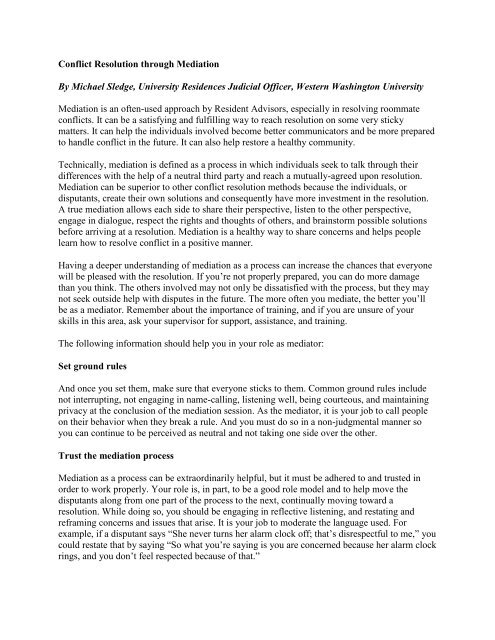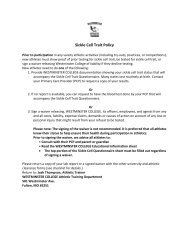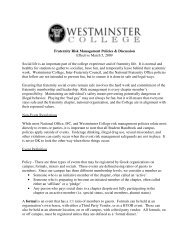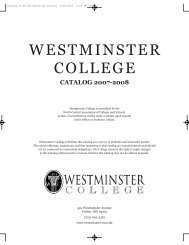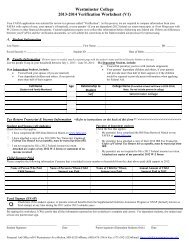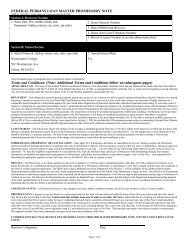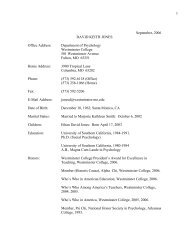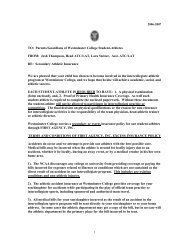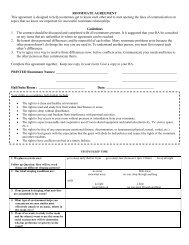Conflict Resolution and Mediation 101 - Westminster College
Conflict Resolution and Mediation 101 - Westminster College
Conflict Resolution and Mediation 101 - Westminster College
You also want an ePaper? Increase the reach of your titles
YUMPU automatically turns print PDFs into web optimized ePapers that Google loves.
<strong>Conflict</strong> <strong>Resolution</strong> through <strong>Mediation</strong>By Michael Sledge, University Residences Judicial Officer, Western Washington University<strong>Mediation</strong> is an often-used approach by Resident Advisors, especially in resolving roommateconflicts. It can be a satisfying <strong>and</strong> fulfilling way to reach resolution on some very stickymatters. It can help the individuals involved become better communicators <strong>and</strong> be more preparedto h<strong>and</strong>le conflict in the future. It can also help restore a healthy community.Technically, mediation is defined as a process in which individuals seek to talk through theirdifferences with the help of a neutral third party <strong>and</strong> reach a mutually-agreed upon resolution.<strong>Mediation</strong> can be superior to other conflict resolution methods because the individuals, ordisputants, create their own solutions <strong>and</strong> consequently have more investment in the resolution.A true mediation allows each side to share their perspective, listen to the other perspective,engage in dialogue, respect the rights <strong>and</strong> thoughts of others, <strong>and</strong> brainstorm possible solutionsbefore arriving at a resolution. <strong>Mediation</strong> is a healthy way to share concerns <strong>and</strong> helps peoplelearn how to resolve conflict in a positive manner.Having a deeper underst<strong>and</strong>ing of mediation as a process can increase the chances that everyonewill be pleased with the resolution. If you’re not properly prepared, you can do more damagethan you think. The others involved may not only be dissatisfied with the process, but they maynot seek outside help with disputes in the future. The more often you mediate, the better you’llbe as a mediator. Remember about the importance of training, <strong>and</strong> if you are unsure of yourskills in this area, ask your supervisor for support, assistance, <strong>and</strong> training.The following information should help you in your role as mediator:Set ground rulesAnd once you set them, make sure that everyone sticks to them. Common ground rules includenot interrupting, not engaging in name-calling, listening well, being courteous, <strong>and</strong> maintainingprivacy at the conclusion of the mediation session. As the mediator, it is your job to call peopleon their behavior when they break a rule. And you must do so in a non-judgmental manner soyou can continue to be perceived as neutral <strong>and</strong> not taking one side over the other.Trust the mediation process<strong>Mediation</strong> as a process can be extraordinarily helpful, but it must be adhered to <strong>and</strong> trusted inorder to work properly. Your role is, in part, to be a good role model <strong>and</strong> to help move thedisputants along from one part of the process to the next, continually moving toward aresolution. While doing so, you should be engaging in reflective listening, <strong>and</strong> restating <strong>and</strong>reframing concerns <strong>and</strong> issues that arise. It is your job to moderate the language used. Forexample, if a disputant says “She never turns her alarm clock off; that’s disrespectful to me,” youcould restate that by saying “So what you’re saying is you are concerned because her alarm clockrings, <strong>and</strong> you don’t feel respected because of that.”
Consider….Room Contracts! A great resource <strong>and</strong> tool is a roommate contract, a documentoutlining all the rules <strong>and</strong> expectations that the roommates agree to uphold within the room. Itcan be used as a proactive tool that all roommates complete during the first week of school or itcan be utilized during a mediation as a guideline to discussing issues. A roommate agreementcan be found on the resource page online.Also give your residents The Good Roommate Guide. Effective communication among theroommates is the key to resolving any type of conflict, particularly roommate issues.Underst<strong>and</strong> the limits of mediation<strong>Mediation</strong> can be most helpful in many roommate or community disputes. There are, however, anumber of circumstances in which mediation is not the proper solution. In instances whereviolence has occurred, or may occur, mediation is inappropriate because either the threateningatmosphere places one of the disputants at a disadvantage, or a disputant enters the mediationwith motives that are incompatible with the process. For the same reasons, sexual assault, datingviolence or stalking are also poor choices for mediation. Lastly, disputes that involve individualswith a wide disparity in power (e.g. dean of a department <strong>and</strong> a student) can be problematic <strong>and</strong>are not advisable.Be neutralSome professional mediators would say that a true mediator shouldn’t know any of the partiesinvolved in a mediation session. Others would say that as long as you can be neutral, <strong>and</strong> areperceived to be neutral, you can operate as a mediator. It helps to note any relationship that youhave with the parties involved. For example, it’s all right to say “Even though Joe was myresident last year <strong>and</strong> I’ve known him longer, I believe I can be a neutral mediator in thisprocess. Are you both okay with that?” Of course the best course of action would be to haveanother RA mediate a dispute between your residents. You could return the favor when otherRA’s have disputes within their community. This insures neutrality, both in real <strong>and</strong> perceivedterms.Take appropriate timeYour residents have 45 minutes between classes <strong>and</strong> they want you to do the mediation in thattime? Look for another opportunity to meet with them. One of the biggest mistakes in mediationis not allowing enough time for the process to take place. All parties (including you) need tohave two hours, at minimum, to get things going. And everyone should underst<strong>and</strong> that you maynot get finished in that time; you may need to schedule another time (or times) to keep theprocess going. Time is a limited resource, especially for college students, but it is one of the keyingredients for a successful mediation.Be patientWhile it may seem that all the issues are on the table, there may be more lurking unseen to youreye. If either or both disputants seem hesitant or can’t seem to move forward, there may be more
going on than you are aware of. If you try to move along too quickly, issues that need attentioncan be left out <strong>and</strong> consequently come back to haunt you, <strong>and</strong> the disputants, later. Make certainthrough restating <strong>and</strong> reframing concerns <strong>and</strong> issues that everything is out in the open beforemoving on. And remember that just because you feel like you’re ready for the next step doesn’tmean it’s time to take that step. Everyone involved must be ready to do so or mediation doesn’twork.Do not offer solutionsMany people attracted to the RA position are natural helpers, <strong>and</strong> many RA’s reflexively offerideas, suggestions or solutions in everyday life. But offering solutions to problems is not part ofthe mediation process. Technically speaking, if the neutral party comes up with the solution,that’s called arbitration. Another key ingredient in mediation is to make certain the partiesinvolved are arriving at their own decisions <strong>and</strong> solutions. You can ask them prompt questions toget this part of the process moving (e.g. “Are there any other ideas that you have about solvingthis issue?”), but be sure not to lead, or mislead them. As a staff person, you will be a trustedindividual <strong>and</strong> the participants might agree with your suggested solution – which might work foryou, but you are not one of the individuals who will be living with the outcome.Get the agreement in writingOnce the disputants have arrived at a resolution, it is imperative to get the agreement in writing.But before that, be certain that all the bases are covered regarding details <strong>and</strong> feasibility. Playdevil’s advocate <strong>and</strong> attempt to find problems in the resolution. Ask if everything seems realistic.Ask what will happen if an agreed-upon term is not met, or an obligation goes unfulfilled. Onceall of the details have been settled, write down the agreement. Make certain that each disputanthas things to do in the agreement; it sends a bad message if three-quarters of the items have onedisputant’s name at the beginning (e.g. “Joe agrees to...”). Each disputant should have a copy totake with them <strong>and</strong> refer to as necessary.Follow-up, Follow-up, Follow-up!It is a good idea to check back with the disputants in a week or so to ensure that the mediatedsolution is being followed <strong>and</strong> working. If they have moved away from the agreed upon courseof action, you may need to help the disputants to recommit to their initial agreement, or you mayuse the current situation to do a secondary mediation <strong>and</strong> which will allow them to outlineadditional solutions.


